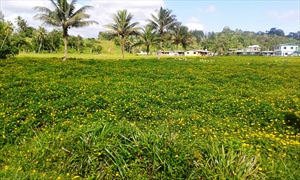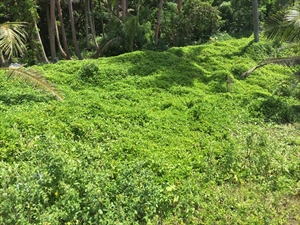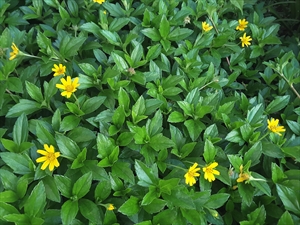- Widespread. Africa, Asia, North, South and Central America, Caribbean, Europe, Oceania. In most Pacific islands.
- Important invasive, creeping, perennial weed of forests, forest margins, open woodlands, wetlands, roadsides, waste areas, and coastal vegetation, forming extensive, dense, ground cover, crowding out other species.
- Up to 70 cm tall; stems green, up to 2 m long, sometimes hairy. Leaves, three lobes (centre one larger), paired along stem, glossy, with saw-like margins, without leaf stalks. Flowerheads, bright yellow, daisy-like, borne singly off side branches, 20-30 mm across, each with 8-13 flowers at the margin, with yellowish petal-like leaves; smaller flowers at the centre.
- Spread: stems or stem fragments (moved in waste or flood water) that readily form roots; moved as an ornamental.
- Biosecurity: high risk of introduction. In Australia, 'restricted invasive plant': do not release into environment, give away or sell. Among 100 of World's Worst Invasive Alien Species (IUCN, 2020).
- Biocontrol: little known.
- Cultural control: hand-pulling; slashing; removing top few cm of soil.
- Chemical control: in Australia: glyphosate; metsulfuron-methyl (and Fiji); glyphosate + metsulfuron-methyl. Elsewhere: 2,4-D; dicamba; triclopyr.
Pacific Pests, Pathogens and Weeds - Online edition
Pacific Pests, Pathogens, Weeds & Pesticides
Wedelia (447)
Wedelia; there are many other names: Bay Biscayne creeping-oxeye; creeping daisy; creeping wedelia; Singapore daisy; trailing daisy; or yellow dots.
Sphagneticola trilobata. It was known previously as Wedelia trilobata. It is a member of the Asteraceae.
AUTHORS Grahame Jackson, Aradhana Deesh & Mani Mua
Adapted from Singapore daisy (Sphagneticola trilobata) (2018) Weeds of SE Qld and Northern NSW. Lucidcentral. (https://www.lucidcentral.org/editors-pick-animal-and-plant-identification-keys/key-to-weeds-of-se-qld-and-northern-nsw); and additional information from CABI (2019) Sphagneticola trilobata (wedelia). Invasive Species Compendium. (https://www.cabi.org/isc/datasheet/56714); and from Sphagneticola trilobata (2019) Wikipedia. (https://en.wikipedia.org/wiki/Sphagneticola_trilobata). Photo 2 Forest & Kim Starr, Starr Environmental, Bugwood.org. Photo 5 Ronggy (2017) Sphagneticola trilobata in Singapore. Photo 6 Hans Hillewaert (2006) Sphagneticola trilobata (L). Pruski. Bay Biscayne Creeping-oxeye at Woodford Hill Beach, Dominica, W.I.
Produced with support from the Australian Centre for International Agricultural Research under project HORT/2016/185: Responding to emerging pest and disease threats to horticulture in the Pacific islands, implemented by the University of Queensland, in association with the Pacific Community and Koronivia Research Station, Ministry of Agriculture, Fiji.










